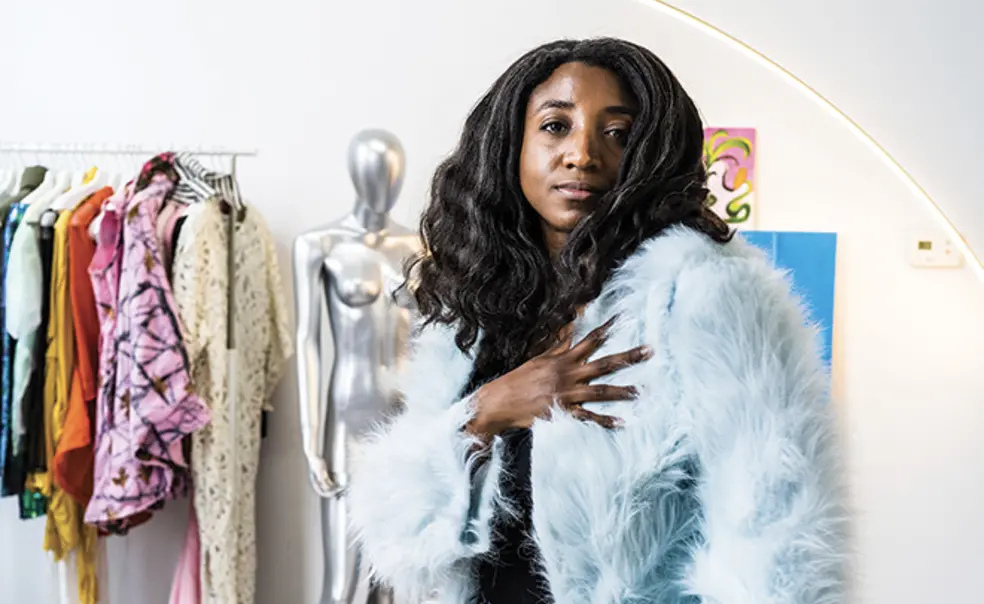Lex Brown ’12 is Teaching the Value of a Multimedia Approach to Art
The practice of switching between materials and media is central to artist Lex Brown ’12’s work. It began at Princeton, where Brown first studied art and archeology as an undergrad and now teaches as a lecturer in visual arts. Her art is like a collage of media: drawing, sculpture, poetry, video, dance, performance art, and text.
“For my thesis, I made four videos, I had sculpture, I did a 33-by-19-foot painting that was just my fingerprints,” says Brown. “I made a book, I did a performance, there was photography. So there was a lot there. And that has remained pretty consistent — using different media.”
This approach has taken her far. After graduating, she earned an M.F.A from Yale’s sculpture program. In 2015, Badlands Unlimited published her sci-fi erotic novella about surveillance and social justice. Last year, she debuted sound sculptures and a short film called “Communication” at the Deli Gallery in New York City; The New York Times called it “funny, absurd, and meditative.” Brown also hosts a podcast and recently designed a hand-bound book called Consciousness — a survey of her work spanning the past eight years.
She’s performed and exhibited at the New Museum, the High Line, the International Center of Photography, Recess, The Kitchen, REDCAT Theater, the Hammer Museum, the Baltimore Museum, the Buffalo Institute for Contemporary Art, and the Munch Museum in Oslo. In 2021, she was named a USA Fellow by the United States Artists Organization and won a $50,000 award. Come April 2023, Brown will exhibit work in a solo show at the MIT List Center, curated by Selby Nimrod.
Teaching is a newer practice for Brown. In 2020, she co-taught a junior seminar at Princeton and became a Media Fellow at Harvard University. Teaching has challenged her to pick apart her own habits and practices as an artist as she guides students through studio classes at Harvard such as “Enter the Mediaverse.” Currently, she is working with Princeton students in the PICASSO Club, a student service organization focused on the intersection of art and activism, on a figurative mural project that will be installed in the basement of Bloomberg Hall.
Brown has long been interested in using art and performance to explore themes of technology, history, and spiritual resilience. “I’m interested in the general anxiety of technology, the general oppression — the big blobby form of it,” she says. “The way that takes shape is through very satirical narratives.”
Take “Communication,” Brown’s 30-minute short film in which she plays nine characters. The plot is centered around a fictional media empire called Omnesia (a combination of “Omni” and “amnesia”) with “massive control over the lives of ordinary people.” Protagonist Aspen Van Der Baas and her “tech bro” friend Jordie use an artificial intelligence bot named Silvy to coerce people out of their neighborhoods to build a new skyline. The film explores how individuals are molded by algorithms and computational decisions — decisions Brown says are “designed to maximize profit for corporations at the expense of our mental health and physical health.”
“What if we devoted as many resources to advancing emotional intelligence?” Brown says. “Why wouldn’t we want every person to be as healthy as possible so that we can actually make systems rooted in balance, rather than trying to find it in increasing amounts of plastic and junk. We’re literally killing the planet because of unmet emotional needs.”
Brown hopes to continue to instill this multimedia approach in her Princeton students. In the fall she’ll be teaching a drawing class.
“A multimedia approach supports the ability for an audience to connect to some of these more conceptual ideas,” Brown says. “People connect to emotions and ideas differently. By using different media, I’m able to reach somebody through a feeling, and then thought can coexist with that feeling. I think that’s when art is really memorable.”












No responses yet